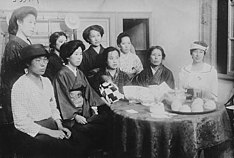
Back حق النساء في التصويت في اليابان Arabic জাপানে নারীদের ভোটাধিকার Bengali/Bangla Frauenwahlrecht in Japan German Sufragio femenino en Japón Spanish حق رأی زنان در ژاپن Persian 女性参政権#日本における女性参政権獲得までの歴史 Japanese
This article needs additional citations for verification. (July 2024) |

Women's suffrage in Japan can trace its beginnings to democratization brought about by the Meiji Restoration, with the suffrage movement rising to prominence during the Taisho period.[1] The prohibition of women from political meetings had been abolished in 1922 after demands from women's organizations led by activists such as Hiratsuka Raichō and Ichikawa Fusae.[2] The movement suffered heavy setbacks during and after the Great Depression, when support for democracy began to wane and military influence over civilians increased dramatically.[3] The first election by universal suffrage without distinction of sex was held in 1946, but it was not until 1947, when the constitution for post-war Japan came into effect, that universal suffrage was established In Japan.[4]
- ^ Ito, Masami (2015-10-03). "Women of Japan unite: Examining the contemporary state of feminism". The Japan Times Online. ISSN 0447-5763. Retrieved 2019-06-05.
- ^ Kuninobu, Junko Wada (1984). "The development of feminism in modern Japan". Feminist Issues. 4 (2): 3–21. doi:10.1007/bf02685546. ISSN 0270-6679. S2CID 144253887.
- ^ "The Rise and Fall of Taishō Democracy: Party Politics in Early-Twentieth-Century Japan". nippon.com. 2014-09-29. Retrieved 2019-06-05.
- ^ "THE CONSTITUTION OF JAPAN". japan.kantei.go.jp. Retrieved 2019-06-05.